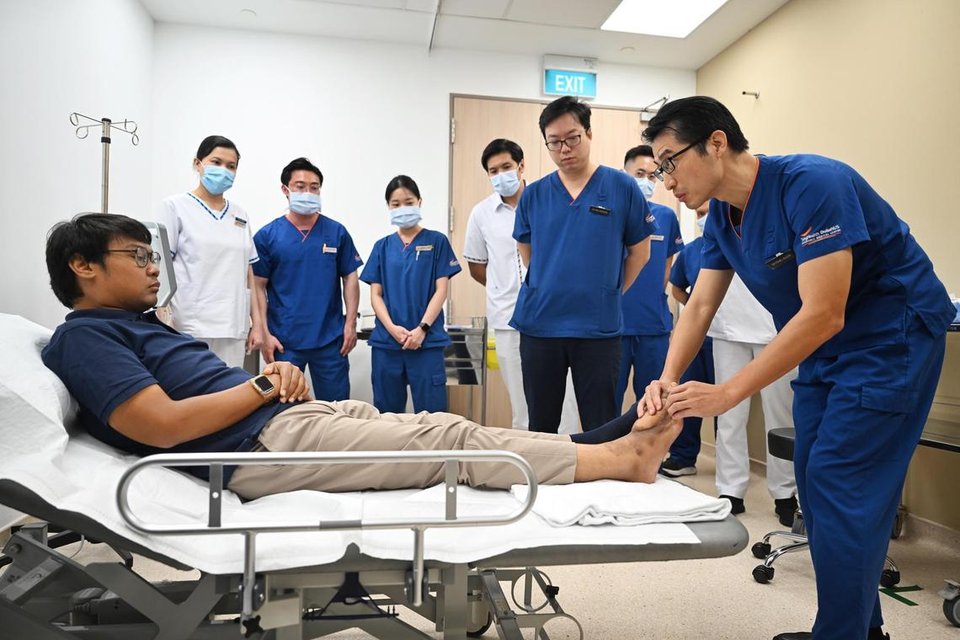Community hospitals need to evolve beyond step-down care: Ong Ye Kung

Published on
14 Sep 2024
Published by
The Straits Times
SINGAPORE – Community hospitals in Singapore will have to evolve beyond their current role as step-down care providers for patients referred by acute hospitals, and become more anchored in community care.
This is as Singapore is undergoing a major healthcare reform towards preventative care, where more resources are being put into the community to help citizens stay healthy, instead of focusing efforts on treating illnesses in hospitals.
Minister for Health Ong Ye Kung gave more details about his vision for the community hospital sector in a speech at St Luke’s Hospital’s (SLH) 28th anniversary charity dinner held at One Farrer Hotel on Sept 13.
Mr Ong said the sector needs to move in three directions.
First, community hospitals need to expand their range of services beyond step-down inpatient care, into areas such as palliative care.
While the majority of Singaporeans wish to die at home, about 60 per cent of Singaporeans still pass on in hospitals.
“Delivering palliative care should not be the sole responsibility of our hospices, which are doing a tremendous job. The closer a care organisation is to the community, the more it needs to develop capabilities in palliative care. Hence, community hospitals, transition care facilities and nursing homes must all be able to offer palliative care eventually,” said Mr Ong.
Second, Singapore needs to ensure that the most appropriate care is given to patients.
Balance needs to be struck between being too conservative and prolonging a patient’s stay in acute hospitals for fear of their condition worsening, and being too liberal such that even patients who are well and should recover at home end up in a community hospital, said Mr Ong.
“It’s like Goldilocks – we have to do it just right.”
Citing the example of Ng Teng Fong General Hospital (NTFGH) and Jurong Community Hospital (JCH), which are part of an integrated development, Mr Ong noted that healthcare workers at JCH actively visit patients in NTFGH’s acute wards to identify those suitable to be transferred to the community hospital.
With such efforts, the combined average length of stay for acute and community days has nearly halved, from about 43 days to 23 days.
This is because an earlier transfer to a community hospital allows patients to benefit from early physiotherapy and rehabilitation, avoiding deconditioning – or losing strength or fitness – due to lack of activity.
“We should therefore try to make admission to community hospitals more flexible, yet appropriate. There needs to be adequate governance and gatekeeping to ensure appropriate care and utilisation of resources,” said Mr Ong.
He added: “We are making steady progress in expanding the referral pathways to community hospitals. Emergency departments of hospitals are able to make direct referrals to community hospitals. They have been able to do so for a long time, but I think community hospitals and acute hospitals need to collaborate more closely to better utilise this referral route.”
The Ministry of Health is also reviewing other referral sources to community hospitals, such as nursing homes, he added.
Third, the community care sector will also need to step up efforts to develop manpower.
This can include new skills for existing healthcare professionals, training potential employees, or preparing laypeople to perform basic caregiving tasks for their loved ones or in the community.
“If prompt and appropriate care can be delivered at home or in the community, we can often avoid a trip to the emergency department or long stays in acute hospitals,” said Mr Ong.
At the event, SLH officially launched its Integrated Rehabilitation Exercise Programme (iRex).
One aim of the programme, which began in May 2023 as a pilot, is to encourage its elderly patients to go beyond restoring their physical function through rehabilitation, to improving their fitness so they can enjoy an improved quality of life.
Currently, community hospitals in Singapore focus their efforts on rehabilitation, like helping stroke patients learn to walk or go to the toilet by themselves again, said SLH’s acting deputy head of rehabilitation Isabella Liang.
“But life doesn’t stop for patients after they regain function, right? If we look at the national directives now, we also want Singaporeans to age well. After they have regained their function, they might want to build their stamina or improve their fitness,” said Ms Liang.
To help patients enhance strength, balance and endurance, iRex offers tailored programmes like personalised fitness training, or group exercises for those who have completed their rehabilitation.
Nearly 1,200 patients have gone through the programme, and over 50 per cent of patients report feeling less fatigued and more energised for daily activities.
About 20 per cent of patients have seen an increase in grip strength, which is an indicator for heart health. Some 10 per cent of patients found it easier to stand up from a seated position, which is an indicator used to measure frailty.
One beneficiary of iRex is delivery driver Ng Keng Hong, 71, who lost the ability to move the left side of his body after suffering a stroke in May 2023.
After undergoing rehabilitation for four months at SLH, he learnt to walk again and made a full recovery.
Motivated by his progress, he joined iRex on the recommendation of the rehabilitation team. After attending light aerobics classes for around three months, his energy levels have also improved.
“When I’m doing deliveries now, I make it a point to take the stairs if the delivery location is under three floors,” said Mr Ng.
Source: The Straits Times © SPH Media Limited. Reproduced with permission.
ALL views, content, information and/or materials expressed / presented by any third party apart from Council For Third Age, belong strictly to such third party. Any such third party views, content, information and/or materials provided herein are for convenience and/or general information purposes only. Council For Third Age shall not be responsible nor liable for any injury, loss or damage whatsoever arising directly or indirectly howsoever in connection with or as a result of any person accessing or acting on any such views, content, information and/or materials. Such third party views, content, information and/or materials do not imply and shall not be construed as a representation, warranty, endorsement and/or verification by Council For Third Age in respect of such views, content, information and/or materials.







